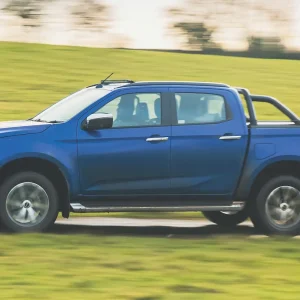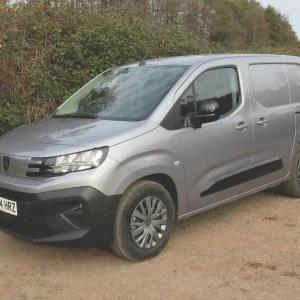Making its UK public debut at this year’s Commercial Vehicle Show back in April, Mercedes-Benz’s latest Vito is embarking on a somewhat thankless task.
It is being asked to take on the outstanding Ford Transit Custom and the almost-as-good Vauxhall Vivaro/Renault Trafic; both vans share the same basic design. It’s starting on the back foot too as it has never been as popular in Britain as big-brother Sprinter or captured the imagination in quite the same way.
Unusually for the 2.8- to 3.2-tonne sector of the market the new Vito is being offered with the choice of either front- or rear-wheel-drive.
Go the latter route and your van will be powered by a 2.1-litre BlueTec diesel at 136hp (114), 163hp (116) or 190hp (119) that meets the Euro 6 exhaust emission standard in advance of its mandatory adoption. All rear-wheel-drive Vitos come with BlueEfficiency, which includes Start/Stop.
At 88hp (109) or 114hp (111), the 1.6-litre CDi diesel employed in front-wheel-drive models is Euro 5, which means it will have to be replaced by a Euro 6 version within the next 12 months or so.
Now with a re-designed cab interior, all Vitos come with a six-speed manual gearbox with the 7G-Tronic Plus automatic transmission available as an extra cost option on 114 and 116 models. It is standard on the 119.
With three lengths (Compact, Long and Extra-long) and two wheelbases, Vito van load cubes range from 5.8cm3 to 6.9m3. Payload capacities run from 870kg to 1280kg.
We opted to tackle a 114 BlueTec Long with 136hp on tap.
Load area
Access to the 6.3m3 cargo area is by means of a standard sliding door on each side and through twin rear doors that can be pushed through 90 degrees then through 180 degrees. You will pay more for that extra offside door if you buy a Transit Custom or Vauxhall Vivaro/Renault Trafic but it is included in the deal if you go for a Peugeot Expert.
Eight tie-down rings are provided in Vito along with a full-height steel bulkhead that bulges back into the cargo space.
While over-length items can be pushed a little way beneath the bulkhead thanks to the way in which it has been designed, there is no load-through facility of the kind available on, for example, Trafic and Vivaro. In other words ladders, planks and so on cannot be slid under the front seats; a surprising omission.
A tailored timber cargo bed cover with a slip-resistant resin coating forms part of the package. Optional ply trim partially protects the cargo bay’s sides and doors from scratches and scrapes but not the wheel boxes.
Gross payload capacity is 1150kg, gross towing capacity is 2000kg and our Vito test van grossed at 3050kg.
Looking at the competition, the nearest equivalent from Vauxhall is the 2900 L2H1 1.6CDTi Vivaro with 140hp on tap. At 6.0cu m it offers a bit less space but around 100kg more payload capacity.
Ford’s closest offering is the Transit Custom 290 L2H1 with 155hp on offer. It delivers significantly more load room at 6.8cu m but carries around 100kg less.
Cab and equipment
To describe Vito as having a three-seater cab is somewhat misleading. The way in which the dashboard bulges out to accommodate the gear-lever significantly restricts the inboard passenger’s legroom; and while the dashboard is well-put-together, its styling falls well short of the flair shown by certain rival manufacturers.
At least there is no shortage of storage space although it’s a shame you cannot pull up the passenger seats and stash items in the void created underneath. We also missed being able to flip down the back of the centre seat and turn it into a desk.
There are however big bins in each of the doors complete with a moulding to hold a flask or a large bottle of water. A small bin is positioned above the big bin in each case.
The glove-box is lidded and lockable and three shelves on top of the fascia will doubtless soon fill up with all the bits and pieces drivers carry around with them. Anything that fails to find a home may end up stuffed into the cubby-holes in the front of the dashboard, which has a cup-holder at either extremity which can also play host to the removable ashtray.
Mercedes adheres to ultra-high safety levels and Vito comes with Crosswind Assist as standard. The idea is to ensure that it is not blown into an adjacent lane if it is hit by a gale on an exposed section of motorway.
TPMS – Tyre Pressure Monitoring System – is included in the price as is cruise control with a Speedtronic variable speed-limiter. So is Attention Assist which alerts you if it thinks you are nodding off at the wheel and encourages you to stop for a coffee; hence the coffee cup symbol on the dashboard.
Adaptive ESP (Electronically Stability Programme) 9i is fitted along with ABS, Electronic Brakeforce Distribution, Anti-Slip Regulation (a traction control system), Brake Assist System, Roll Movement Intervention and Roll Over Mitigation. Disc brakes – ventilated at the front – are installed all round.
A pity Mercedes has not seen fit to copy the blind-spot mirror on the passenger sun visor available in Vauxhall’s Vivaro and Renault’s Trafic. While its distorted presence may make passengers feel a little queasy, it also makes it less likely that the driver will flatten a cyclist sneaking up on the inside.
Driver and passenger airbags are provided as is a radio with USB, aux-in and SD card sockets and slots and remote controls on the steering wheel. Bluetooth compatibility, an iPod interface and a telephone keypad are all included in the Audio 15 infotainment package.
Electric windows and mirrors are fitted as well and the heating and ventilation system features sensibly-chunky controls which can be used to alter the temperature and the booster fan speed.
Vito comes with one specification level to which options can be bolted. Transit Custom is offered with no less than four levels while Vivaro is up for grabs with two.
One of them is Sportive which has gained quite a following among the image- conscious.
The list of options provided with our Vito included front fog lights, air-conditioning and Lane Keeping Assist. Start day-dreaming and drifting out of lane on a motorway or dual carriageway and an alert should jolt you back to wakefulness and back on course.
Also included was Collision Prevention Assist. It monitors the distance between you and the vehicle in front and gives audible and visual warnings if you get too close.
The options included height- and rake- adjustment for the steering wheel – something which should really be standard – along with a height-adjustable Comfort seat.
Powertrain
Turbocharged, intercooled and equipped with common rail fuel injection, our test vehicle’s four-cylinder 16-valve diesel kicked out its maximum horsepower at 3800rpm. Maximum torque of 330Nm makes its presence felt across a 1200rpm-to-2400rpm plateau.
Look under a flap by the passenger door on the nearside of the vehicle and you will find the clearly-marked AdBlue top-up point (a requirement for this Euro 6 engine) beneath the diesel filler point. Drivers are unlikely to confuse the two; at least one hopes they won’t.
Chassis and steering
Independent suspension with MacPherson struts and a stabiliser is installed at the front with an independent semi-trailing-arm set-up helping to suspend the rear. Shod with Michelin Agilis 51 205/65 R16 C tyres, our demonstrator’s 16ins steel wheels featured full-diameter plastic covers which were also included in the options line-up.
Electric power steering is fitted offering a 11.8m turning circle between kerbs shrinking to 11.1m between walls.
Performance
A slick gear-change allows you to make the most of the performance on tap although our demonstrator was a bit slow off the mark.
Accompanied by a pleasing growl, mid-range acceleration proved to be strong though and the van soon got into its stride. However its top-end performance is best-described as acceptable rather than outstanding.
We’d no complaints about the handling or about Vito’s low-speed manoeuvrability. Accessing tight parking spaces was made a lot easier by the optional rear-view camera which delivers a clear image to the 5.8ins screen in the middle of the dashboard.
The image includes dynamic guidelines that indicate the direction of travel.
In-cab noise levels are well-controlled, and while the ride can be slightly ragged on occasions it is smooth and drama-free for the majority of the time.
We still cannot learn to love the foot-operated parking brake. Applied using a little pedal next to the clutch pedal, you release it by pulling a lever on the dashboard to the accompaniment of a loud bang.
At least Vito is fitted with Hill Start Assist as standard. Without it, the combination of a manual gearbox and a foot-operated parking brake would make moving away on a slope without rolling backwards a challenging exercise.
Buying and running
Service intervals are typically set at two years/25,000 miles with the Assyst onboard computer telling you if your van needs to visit the workshop.
Vito is protected by a three-year/unlimited mileage warranty and a 12-year anti-perforation corrosion warranty. Unusually, the MobiloVan programme delivers complimentary roadside assistance for 30 years from the date of first registration provided the van is serviced regularly by a Mercedes-Benz dealer.
Vito returns 44.1mpg on the official combined cycle but we were averaging closer to 40.5mpg. The Vivaro and Transit Custom we referred to earlier deliver official combined returns of 46.3mpg and 40.9mpg respectively.
Good to see a full-size spare wheel on Vito but it’s a shame the body does not enjoy the protection of side-rubbing strips. That makes it vulnerable to minor scratches and scrapes.
You can lock and unlock the doors using a button on the driver’s door. The remote central locking fob allows the load area doors to be locked and unlocked separately.
One feature that caught our eye is the QR code for use by the emergency services if Vito is involved in a smash. Positioned on the cab’s B-pillars, it allows them to scan it and see exactly where the fuel tank, airbags and electric cables are all located.
Verdict
A well-put-together package and again we’d like to applaud the stress on safety, but there is little evidence of the design flair shown by certain rivals.
Mercedes-Benz Vito 114 BlueTec Long
Price (ex VAT) – £20,860
Price range (ex VAT) – £17,855-£27,510
Gross payload – 1150kg
Load length – 2831mm
Load width – (min/max) 1270mm/1685mm
Load bay height – 1392mm
Load volume – 6.3cu/m
Loading height – 558mm
Rear door aperture – 1391mm x 1261mm
Side door aperture – 961mm x 1252mm
Gross vehicle weight – 3050kg
Braked trailer towing weight – 2000kg
Residual value* – 21.6%
Cost per mile* – 42.0p
Engine size/power – 2143cc, 136hp @ 3800rpm
Torque – 330Nm @ 1200-2400rpm
Gearbox – 6sp
Fuel economy – 44.1mpg (combined)
Fuel tank – 75 litres
CO2 – 169g/km
Warranty –3yrs/unltd miles
Service intervals –2yrs/25,000 miles
Insurance group – 9ET1
Price as tested – £24,848
*After 4yrs/80,000miles, Source: Mark Jowsey
Options fitted
Pre-installation for Becker Map Pilot – £233
Electrical components for trailer tow-bar socket – £90
Tempmatic air-conditioning – £895
Collision Prevention Assist – £205
Lane Keeping Assist – £415
LED light strip in load compartment – £85
Leather-covered steering wheel and gear-shift lever – £185
Rain sensor – £101
Full wheel covers – £75
Comfort driver’s seat – £100
Wood load space interior trim – £260
Height- and rake-adjustable steering wheel – £104
Large fuel tank – £75
Halogen front fog lamps – £185
Reversing camera – £450
Upgrade to 3050kg gross weight – £530
History
With one load cube (4.8m3) and one payload capacity (1055kg), the one-size-fits-all front-wheel-drive Spanish-built Mercedes-Benz Vito that debuted almost 20 years ago was aimed at buyers who wanted something smaller than a Sprinter.
Initially powered by somewhat pedestrian diesels, the common rail engine subsequently fitted and offered at up to 122hp made it a far more satisfactory load shifter. The up-rated gearbox and clutch helped too and contributed to What Van?’s decision to make the Mercedes its Van of the Year for 1999.
The really big changed occurred at the end of 2003 with the launch of an all-new rear-wheel-drive Vito offering three different lengths, a high roof option and a re-designed interior and exterior. Subsequent upgrades included the introduction of Euro 5 models in 2010 and the arrival of an electric version.
It is of course worth noting that Vito continues to be marketed as a crew van with a second row of seating plus a load compartment at the rear.





